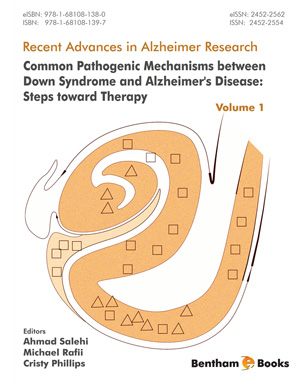Abstract
Down syndrome (DS) is characterized by several structural and functional anomalies present from prenatal stages that lead to intellectual disabilities. In later life stages, the cognitive abilities of DS individuals progressively deteriorate due to the development of Alzheimer’s disease (AD) neuropathology (i.e., β-amyloid [Aβ] plaques, neurofibrillary tangles [NFTs], neurodegeneration, synaptic pathology, neuroinflammation, and increased oxidative stress). Different mouse models of DS have been created based on the homology of human chromosome 21 (Hsa21) and on several syntenic regions of murine chromosomes 16, 10 and 17. In addition, a transchromosomic model (Tc1) bearing a triplication of most Hsa21 genes has been developed. Although DS models display agerelated neurodegeneration and many hallmarks of AD neuropathology DS models do not develop Aβ plaques or NFTs; however, increases in soluble and insoluble Aβ species and hyperphosphorylated tau are present in many of these models. In addition, many murine models of AD have also been created. Because the triplication of the App gene in mice does not lead to Aβ plaque development, numerous transgenic models bearing APP gene mutations found in familial AD have been developed. These mice display Aβ peptide aggregation and other AD-like neuropathological markers; however, these mice do not develop NFTs and neurodegeneration is absent in most of these mice. A second generation of AD models was created by crossing different APP transgenic mice with animals bearing mutations in the presenilin (PS) 1 or PS2 genes. Most of these models display NFTs, an earlier appearance of Aβ plaques and neurodegenerative processes. Finally, triple transgenic mice, bearing mutations in the APP, PS1, and tau genes have been developed, leading to a model that displays most of the AD neuropathological alterations and an earlier onset of the cognitive deficit. The AD models differ in many phenotypes due to variations in the mutations carried by each model, the promoters used and the background strain. However, the similarities between these models have provided extremely valuable insights into AD etiopathology. This chapter analyzes the similarities and differences between the most commonly used DS and AD mouse models, supporting the hypothesis that some pathological processes appearing earlier than Aβ plaques and NFTs, such as synaptic alterations, oxidative stress, and neuroinflammation, could be increasing the soluble and insoluble Aβ species that could exacerbate tau pathology and neurodegeneration. In summary, both DS and AD mouse models are extremely valuable tools for understanding the etiology or neuropathological anomalies responsible for the cognitive deterioration found in both conditions.
Keywords: APP, Alzheimer’s disease, Down syndrome, mouse models, neuroinflammation, tau, Ts65Dn.






















